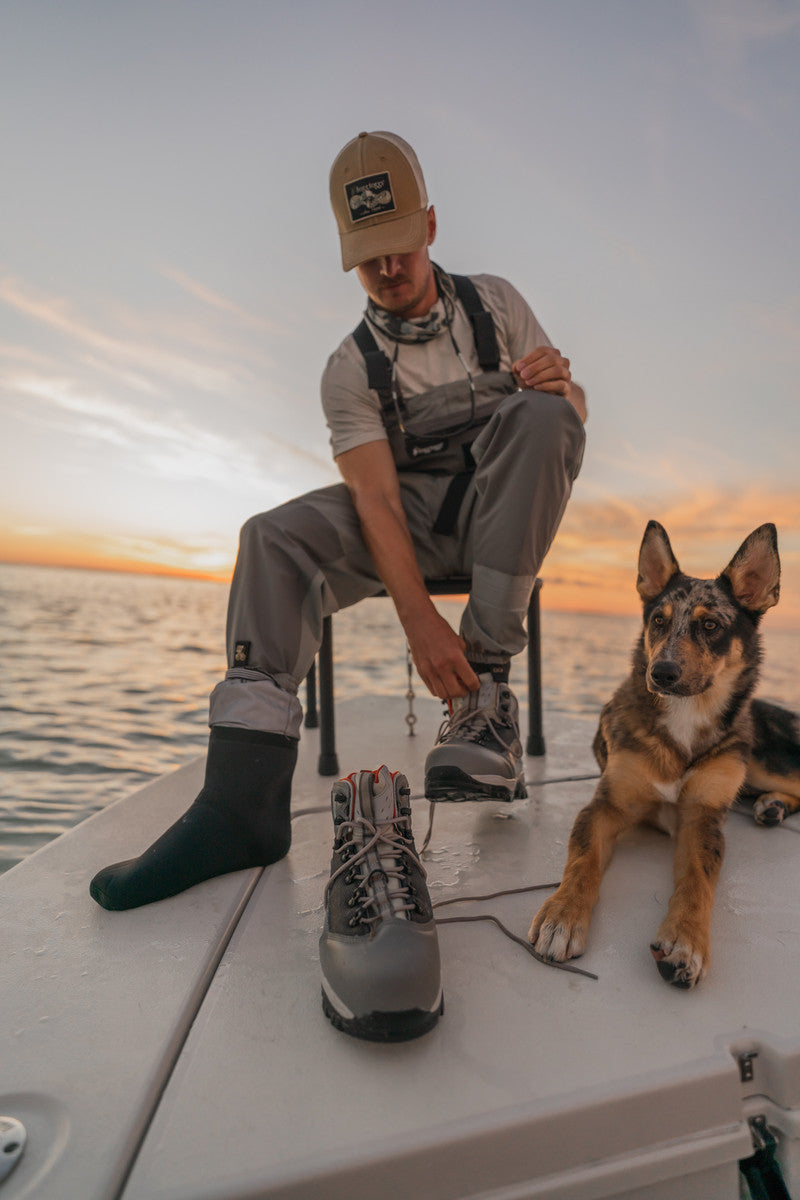
How to Buy Waders
Wader Buying Guide
If you’re wondering how to buy a pair of waders, let our helpful guide give you the knowledge you need to make an informed choice. We'll navigate the diverse options, exploring types like fishing and waterfowl waders, their varying profiles from hip to chest, and the materials used to make them, from breathable fabrics to rugged rubber. We’ll also provide essential sizing tips and look at the differences between bootfoot versus stockingfoot styles. Whether you're heading out for a day of fishing or embarking erson an exciting waterfowl hunt, our waders guide will help you choose the best pair to keep you dry and comfortable through it all.
Types of Waders
The three types of waders for fishing or waterfowl hunting are hip, waist, and chest waders. Choose a specific type based on the water’s depth, the speed and strength of its current, and your preferred level of protection.
Hip Waders
Hip waders offer a good option for navigating shallow waters, and extend down to the stocking- or bootfoot from just below the hips like a pair of chaps. They're ideal for low-current environments where deep wading isn't necessary. If you plan to encounter deeper water or stronger currents, opt for waders with more coverage, like waist or chest waders, for better protection and safety.
Waist-High Waders
Waist-high waders, also known as wader pants, begin at your waist and provide coverage on the lower body. They're ideal for wading in moderate water depths and offer significant warmth for fishing or hunting in cold environments. Because waist-high waders do not cover the upper body, they allow for airflow up top and thus also help regulate your temperature during warmer days.
Chest Waders
Chest waders offer the most coverage, and feature a bib secured in place by suspenders to protect the upper body against deeper water and unexpected splashes; they're suitable for a wide range of water
depths. This extra coverage also provides added security against sudden dips or missteps, making them ideal for navigating uneven or uncertain terrain.
Bootfoot vs Stockingfoot Waders
Chest and waist-high waders come in bootfoot and stockingfoot styles, offering different levels of flexibility and customization. We'll explain the options to help you make an informed choice based on your specific needs.
Bootfoot Waders
Bootfoot waders feature integrated boots, eliminating the need to purchase boots separately, and making gearing up simpler. They excel at keeping out dirt, sand, and debris due to the one-piece construction. But the lack of laces limits customization for personalized fit. Bootfoot waders come in three main sole types, each offering unique advantages for specific conditions.
- Rubber Sole Boot– The tread and traction on a rubber sole is similar to a hiking boot. It works well for muddy or marshy conditions and is a good multi-use wader.
- Felt Sole Boot – The cloth sole on a felt boot provides excellent traction on slippery river rocks. Felt can wear down over time, but replacement soles can restore comfort and stability to the boots.
- Cleated Sole Boot – Also called a studded sole, this boot style offers plenty of traction and stability, ideal on slippery leaves and slick river bottoms.
Note: Felt waders are banned in some states, as the soles can transfer invasive aquatic species from one body of water to the next. Check with area regulations before use.
Stockingfoot Waders
Often favored by anglers, stockingfoot waders are lighter, more comfortable, and pack more easily due to the lack of an integrated boot. This allows for better customization, as you can choose separate wading boots that offer the specific features you want, including the type of outsole and the lace style to best suit your needs.
What Are Waders Made Of?
Fishing and waterfowl waders typically come in four material options: neoprene, rubber, PVC, and breathable fabrics like nylon or polyester. Each offers distinct advantages and drawbacks, so selecting the material that best aligns with your needs is essential.
Neoprene
Neoprene waders reign supreme in cold-weather conditions, offering superior warmth and insulation thanks to the material's inherent properties. Their durability makes them ideal for navigating harsh environments like marshes or dense brush. While the thickness of neoprene varies—3mm being suitable for fishing and 5mm preferred for colder weather—conventional neoprene is not breathable. Opt for other materials if warm-weather comfort is a priority.
Rubber
Rubber remains a popular choice for hip waders due to its exceptional durability and affordability. This classic material is often combined with Nylon or Polyester for enhanced durability, and resists tearing and puncturing, making it ideal for navigating rocky or brushy terrain. Rubber's limited breathability can cause discomfort in warm weather, and its stiffness can restrict movement compared to other materials.
PVC Waders
Polyvinyl chloride (PVC) waders are a budget-friendly option for fishermen and hunters seeking reliable waterproofing. PVC creates a barrier between you and the elements, keeping you dry and comfortable throughout your adventure. Durable PVC also withstands abrasions, resists damage from UV light, and holds up to the wear and tear of extended use. Plus, these waders are easy to clean, making maintenance simple after a long day outdoors.
Breathable Waders
Breathable waders, constructed from lightweight nylon or polyester with a waterproof membrane, excel in warm weather thanks to their moisture-wicking properties. They can also be suitable for colder weather when layered with appropriate thermals. Breathable waders are not as durable as rubber, particularly in abrasion-prone areas like the knees and seat. For better longevity, look for waders with reinforcements in these high-wear zones.
What’s the Difference Between Fishing Waders and Waterfowl Waders?
While both fishing and waterfowl waders share the core purpose of keeping you dry and comfortable, subtle variations will meet the demands of each activity. Choosing the right type can significantly enhance your outdoor experience.
Fishing Waders
Prioritizing comfort for long periods of standing, fishing waders often feature strategically placed padding, water resistant pockets to hold fishing accessories, and breathable materials. The soles in bootfoot options offer reliable traction, keeping you steady on slippery rocks and muddy riverbeds. Designed to blend seamlessly with natural environments, fishing waders typically come in neutral colors like gray, forest green, and brown, ideal for various types of freshwater fishing.
Waterfowl Waders
Waterfowl hunting involves frequent movement, so these waders prioritize durability with reinforcements in high-wear areas like the knees and seat to withstand the bending, stooping, and crouching that come with navigating rough terrain. Additionally, waterfowl waders typically feature camouflage patterns like Mossy Oak Bottomland and Realtree Max7 to blend in with the reeds, brush, and grasses of swampy environments for better hunting stealth.
How To Size Waders
By now, you might be wondering, "What size waders do I need?" The answer lies in obtaining some key body measurements and following the manufacturer's size chart. Most wader sizes are based on a combination of the chest, waist, hip, and inseam measurements, along with shoe size. Refer to the frogg toggs sizing chart to ensure a perfect fit in your next pair of waders.
